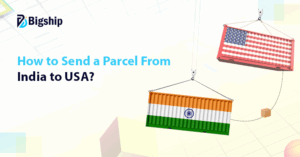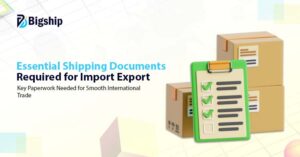While you export goods through courier, you may wonder which courier shipping bill fits your shipment? CSB-IV or CSB-V? Because both sound similar, yet they serve different goals in the export cycle.

Many exporters feel confused here because the rules sound technical. In this blog, you will get to know what CSB meaning is, how each CSB type works, and how you can choose the correct bill for your exporting style.
What does CSB mean in shipping?
CSB or courier shipping bill is a declaration that customs requires for any export moving through courier mode. CSB is a formal note that explains the nature of your export.
A courier shipping bill helps customs identify the shipment. Customs uses the document to see the declared value, the HS code, the exporter’s name, and the intent behind the shipment. It gives clarity to the officers who screen the parcels. This also helps customs decide the rule-set for that export.
Why do exporters need a CSB?
You must file a CSB for every international courier parcel, and it is not optional. Customs will not clear the parcel without it. Here is what a CSB helps customs check:
Value of goods: Customs needs the declared amount to confirm if it fits legal rules.
Product category: Correct product type helps officers identify permitted or restricted items.
Export intent: Customs must know if it is a commercial sale, sample, or an item under a specific trade rule.
Duty rules and export conditions: This helps customs decide the clearance process.
Eligibility for government benefits: When incentives apply, customs checks the CSB before allowing claims.
What is CSB-IV?
CSB-IV is the courier shipping bill used for regular exports, usually non-commercial in nature. It fits shipments that fall under certain value and weight limits. Businesses use it when they export products to customers abroad without claiming export incentives.
When should you use CSB-IV?
CSB-IV becomes the right pick when your export fits specific situations. These situations arise very often for e-commerce sellers and small exporters.
- Small parcels sent to customers abroad usually fall into this category. CSB-IV suits them because customs does not require heavy documentation for low-value exports.
- Many sellers simply want to complete the order and deliver the product. CSB-IV helps them ship without entering into benefit-related paperwork.
- When a brand sends small trial orders or tests a new market, CSB-IV allows them to ship in a simple and predictable way.
Key features of CSB-IV
Certain rules define how CSB-IV works. These rules create a clear boundary for exporters:
Shipment value and weight limits: Customs sets a maximum value and weight for CSB-IV parcels. This ensures only small commercial exports fall under this type. The limits prevent misuse.
HS code identification: Every product must carry the correct HS code. This code decides how customs categorizes the item. CSB-IV needs accuracy here because even a small mismatch may delay screening.
Allowed product categories: Most standard products fall under CSB-IV. But restricted categories cannot be exported using this type. Limited rules keep the export process quick.
Customs screening process: Customs performs a basic check on CSB-IV shipments. Officers verify the declaration, examine the parcel if needed, and clear it once everything matches.
Who Should Choose CSB-IV?
CSB-IV fits exporters who focus on smaller export volumes. Some examples:
D2C exporters: Direct-to-consumer sellers often send small orders to global customers. CSB-IV supports these frequent shipments.
Small e-commerce brands: Sellers on platforms like Amazon, Etsy, or their own storefronts rely on CSB-IV for daily shipping activity.
Brands sending trial orders: Businesses testing global demand usually prefer quick courier shipments. CSB-IV supports early-stage growth.
What is CSB-V?
CSB-V or CSB 5 supports exports tied to government incentive schemes. It applies when the exporter wants to claim benefits like MEIS. These incentives aim to support Indian exporters and increase product demand abroad. CSB-V also supports bulk shipments sent through courier mode. The process involves deeper documentation because customs must verify eligibility for benefits.
When should you use CSB-V?
CSB-V becomes the correct option when your export falls into the following situations:
Bulk exports that move through courier mode: Some exporters ship in higher volumes through courier instead of cargo. CSB-V supports such exports.
Exports where the seller wants to claim benefits: Incentive schemes boost profitability. When the goods fall under eligible categories, CSB-V must be used.
High-value SKUs: CSB-V fits expensive items because customs performs detailed verification and ensures correct compliance.
Key features of CSB-V
CSB-V comes with specific features that explain why it holds more weight during customs checks.
- Exporters must submit extra paperwork so customs can confirm the correctness of the claim.
- Officers examine the details thoroughly because government benefits cannot be approved without strict checks.
- Some goods qualify under MEIS or RODTEP, while others do not. CSB-V only supports goods that follow the benefit guidelines.
- CSB-V is designed for larger commercial exports, so the value limit is broader.
Who should choose CSB-V?
CSB 5 is a great choice for businesses who operate at large scale.
- Established exporters who run steady cross-border operations and depend on incentive claims for better margins.
- High-value shipments that require careful documentation, which CSB-V supports.
- For sellers who rely on incentive-driven exports.
MEIS eligibility rules for CSB-V
Your MEIS claim depends on a few important rules. These regulations are listed below:
- Check if your goods fall under eligible product lists of MEIS.
- Keep all documents clear and complete as customs verifies identity, product details, and export value.
- Each export must match invoice rules, HS codes, and declared values.
- Avoid errors in the declaration because incorrect information may lead to claim rejection.
How to choose the right courier shipping bill for your export type?
A simple method helps you decide your CSB type:
Check the value of your shipment: Small-value parcels usually match CSB-IV rules. Higher-value items suit CSB-V.
Look at your business model: If you export daily and rely on volume, you may need CSB-V. If you run a small brand, CSB-IV may feel natural.
Check your need for incentives: If you want benefits, then CSB-V becomes compulsory. If you only want delivery, then CSB-IV works.
Benefits of using the correct CSB type
Using the right CSB type creates several advantages:
Faster customs clearance: Each CSB type follows its own route at customs. The correct match speeds up approval.
Lower chances of rejection: Customs holds parcels when documents mismatch. The right CSB prevents this.
Better export compliance: Incentive claims depend on correct paperwork. CSB-V supports such claims.
Smoother export operations: Correct classification keeps your shipments steady.
How Bigship helps exporters with CSB-IV and CSB-V shipments?
Bigship helps exporters by reducing paperwork stress. The system prepares documents through automated tools that avoid errors. Also, you receive support from your POC for selecting the correct CSB type as per your shipment.
The platform checks product details so you avoid mistakes during customs filing. Exporters who claim incentives receive guidance on CSB-V filing. Bigship handles operational pressure so you export without confusion.
Key Takeaways
- CSB-IV is used to send small parcels that are categorized as gifts or sample.
- CSB-V means courier shipping bill which is used to send large-scale commercial parcels.
- CSB-IV is suitable for small exporters and trial shipments.
- Documents like GST number, IEC, and HSN code are mandatory for CSB 5.
- CSB 5 is ideal for large shipments that qualify for government incentives.
Conclusion
Both CSB-IV and CSB-V serve different purposes. CSB-IV works well for small exporters, trial orders, and regular courier shipments. CSB-V supports exporters who ship at higher value or depend on incentive claims.
When it comes to choosing a correct shipping provider, Bigship is the ideal choice. It helps you at every stage by preparing your documents clearly and guiding you toward the correct CSB type. This keeps your exports steady and your global growth easier to manage.
Sign up with Bigship and export your shipment with the correct CSB type.





